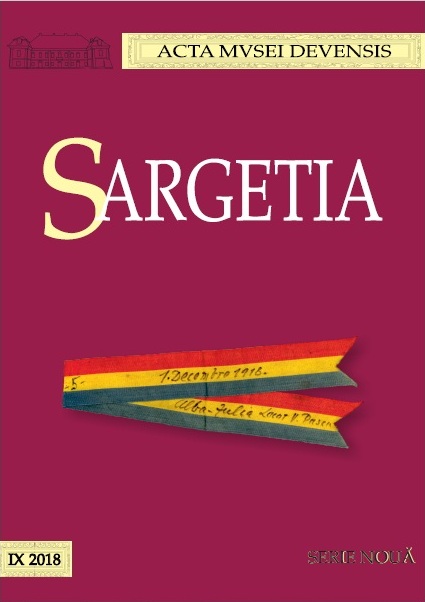Villa romană de la Simeria – Aldăcuțu Mic (jud. Hunedoara). Cercetările arheologice
din toamna anului 2015
The Roman Villa from Simeria – Aldăcuțu Mic (Hunedoara County). The Archaeological Research from the Fall of 2015
Author(s): Marius Gheorghe Barbu, Ioan Alexandru Bărbat, Ioana Lucia Barbu, Costin-Daniel Ţuţuianu, Antoniu Tudor MarcSubject(s): History, Archaeology
Published by: Editura Altip
Keywords: Roman villa; Mureș Valley; Roman constructions; Late Roman structures;
Summary/Abstract: The paper aims to presenting the main results obtained from the preventive archaeological researches carried out at Aldăcuţu Mic between October-December 2015.The site Aldăcuţu Mic is located in the south-west of Transylvania, the archaeological point being in the vicinity of Simeria and the village of Sântandrei, Hunedoara County, in the lane area of Mureş river (Pl. I-II). To the main nearby towns, the Aldăcuţu Mic site is about 1.50 km from the entrance to Simeria from Deva, to the west, and about 1 km away from the northeast of Sântandrei.The site was known in the archaeological literature as a result of the fieldwork undertaken by Eugen Pădureanu in this point in the 1980s, the archaeologist identifying in the central area of the site, on a distance of 1250 m, the traces of a Roman road heading from the center of Transylvania to the Pannonian Plain (Pl. IV/3).Recent archaeological research have identified another section of the mentioned Roman road towards Sântandrei (Pl. IV/1), but especially highlighted the existence of a Roman villa, most probably aligned to the Roman road (Pl. II/1, 3). The same archaeological researches have shown the presence of prehistoric materials, in the archaeological layer.The archaeological excavations carried out at Aldăcuţu Mic revealed several structures from the Roman period, their character indicating that a villa would have most probably functioned here (Pl. V-XVI). The location in the immediate vicinity of the road could also justify the existence of mansiones structures, but in the case of Aldăcuţu Mic, the large extent (approximately 1 ha), the existence of an enclosure wall (Pl. V/1-2) around the structures and the character of annexes households of the buildings identified in the marginal area of the dwelling complex are arguments that we are in front of a rural residence.Three phases of habitation were identified during the Roman period. The first of them, dated to the first three quarters of the 2nd century AD, left little traces of human activity (Pl. VII/6, XI/2-8, XII/1-6), the researched area being at that time a marginal area of the structures of Aldăcuţu Mic. The second Roman phase, dated in the second half of the 2nd century AD and the first part of the following, represents a period of expansion of the dwelling nucleus from here, and now two buildings with stone walls (Pl. VI/1-4) and an annex on wooden pillars can be recorded (Pl. VIII-IX).The last dwelling phase, dated in the middle of the 3rd century AD or in the second part of it, is characterized by the addition of light structures to the old stone buildings (Pl. X/1-6). This last phase seems to be stretching for a relatively long period, the light structures mentioned above knowing a second expansion phase. Probably also in this chronological range, the second stage granary is decommissioned, the space between its pillars becoming a small “workshop” dealing with the recycling of the surrounding metal (Pl. XVI/1-5).
Journal: Sargetia. Acta Musei Devensis
- Issue Year: 2018
- Issue No: 9
- Page Range: 155-188
- Page Count: 34
- Language: Romanian

